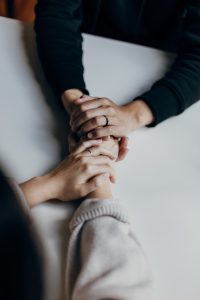28 First Person: My Journey with Trauma and Dual Diagnosis
BY LIZ WILSON

Editor’s Note: This essay mentions domestic violence.
Trauma: An incident and its physiological and psychological effects on victims and/or witnesses to the event. The DSM describes five types of PTSD, the label most commonly associated with trauma. I want to talk about comorbid PTSD, a diagnosis given when other diagnoses exist. In my case, bipolar disorder and substance use disorder.
My first memory is of a staggering, drunken father calling out my name while a frightened mother held my four-year-old mouth and my tiny knees dug into the gravel and sticker plants beneath me. We were hiding. Daddy had a gun. My siblings, mother, and I escaped, and she left dad, us in tow. Still, 44 years later the memory burns in my mind and resurfaces in my life in many ways.
As a counselor, I have taken dozens of classes on trauma informed care, which is quickly becoming the standard in a country where war, abuse, disease, and other trauma are often the order of the day. I am aware of the physiological affects: nightmares, stomach aches, acute anxiety, panic attacks, hypervigilance, yet, as a recovering addict, I am also aware of a lifelong tendency to pick up street drugs in an attempt to treat these symptoms.
I gained that relief at the cost of everything I knew: relationship, job, home, health, and freedom.
When I was 12, my brother—who had become my father figure in Dad’s absence—introduced me to alcohol, speed, and marijuana “to help deal with s*&^ at home.” I was a functional addict for the next few decades, until the trauma came back in the form of my young relative’s molestation. The nightmares returned in earnest, I quit taking my psych medications, I felt helpless and hopeless—and I picked up. As my blog readers know, this led to an obsession with relief, and I gained that relief at the cost of everything I knew: relationship, job, home, health, and freedom.
Having scrambled the eggs of biological, psychological and substance disorders, what was I to do? Below is an outline of how I ultimately broke free and my methodology for staying healthy in the face of global and individual traumas that have since come my way.
Develop a plan. I have a WRAP plan that describes my behaviors in healthy times, pre-crisis, and crisis times. It allows people who know love and treat me to recognize when I am sliding into old, unhealthy patterns. My loved ones and medical professionals all have copies of it.
Take my medicine and listen to (and ASK FOR HELP FROM) my support people. This begins with trusting someone enough to let them be a support person. My medication helps me continue to make sound decisions in the face of crisis.
GIVE MYSELF A BREAK! Dialectical Behavioral Therapy has a wealth of resources accessible online with a simple DBT search, not the least of which is mindfulness. My blog explains some of these practices.
Treat myself as a whole being. Every day I ask how I am with myself spiritually? Emotionally? Physically? You can journal these or just do a “moral inventory” in your head. We are complex beings and recovery is complex, don’t get discouraged—take what works right now and leave the rest.
If you need more information or want to touch base with some really informed folks:
National Center for Trauma-Informed Care
66 Canal Center Plaza, Suite 302
Alexandria, VA 22314
866-254-4819
Fax: 703-548-9517
NCTIC@NASMHPD.org